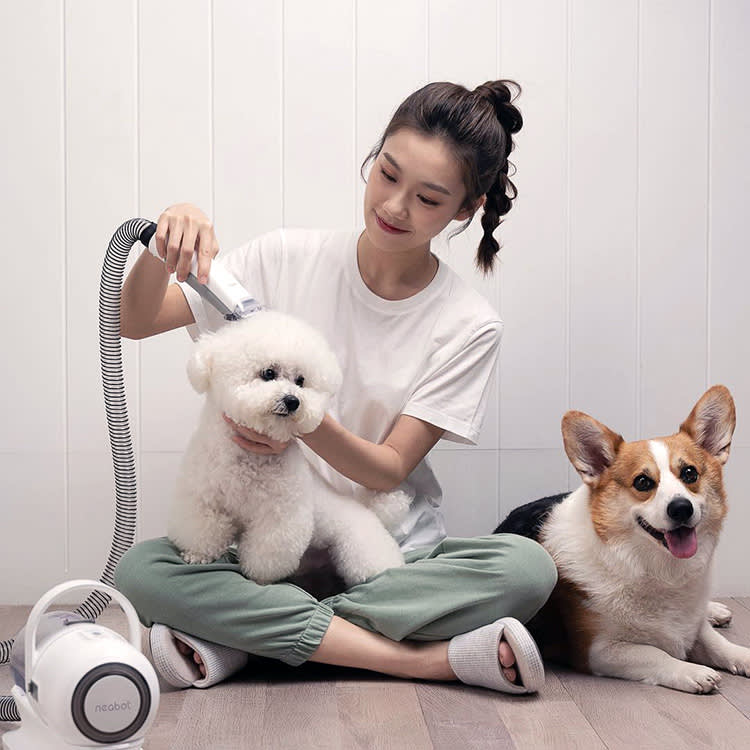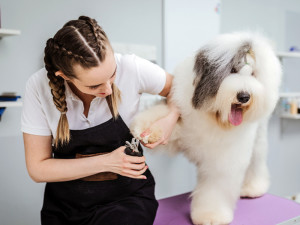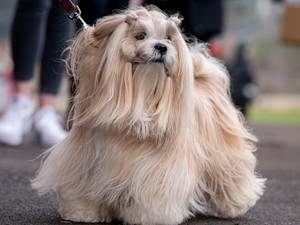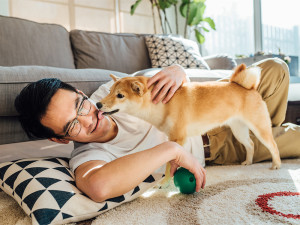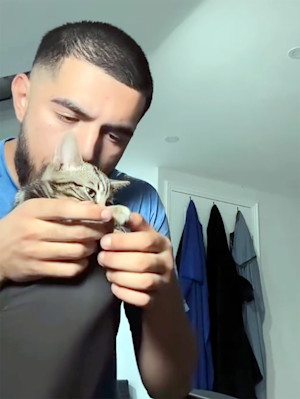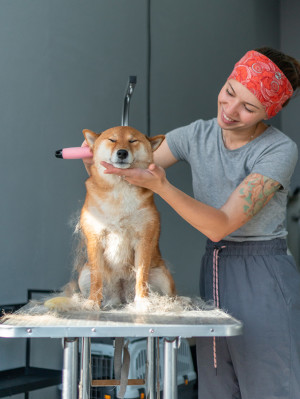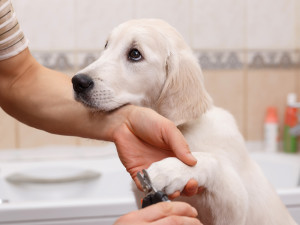Should I Err... Vacuum My Pet?
Just because you can, does it mean you should?
Cartwheeling through the air in clumps, accumulating in corners and sticking to your clothes like Velcro: pet hair is everywhere right now.
Whether you blame it on shedding season or simply have a pet who moults all over your couch/bed/life throughout the year, discarded hair is pretty much part of having a cat or dog. Some breeds are exceptions – Poodles and their various crossbreeds, for example, tend to shed less – but most will steadily re-carpet your home over time. And if you have a house cat that can’t go outside and shake off all that hair? Expect to find it everywhere.
Help is seemingly at hand in the form of the pet vacuum, which you may have seen trending on TikTokopens in new tab. But as so many of these posts are sponsored, it can be hard to sort the fur from the fluff. So, what are they, are they safe and will your pet be a fan? We spoke to two pet experts to find out.
What is a pet vacuum?
Pet vacuums are essentially grooming brushes with suction, which whisk away hair to a separate chamber. Some have various other features and attachments – including the ability to choose a quiet setting – but the basic function remains the same. As you brush, dead hair gets taken away rather than flying around your home, seemingly making for an easier clean-up. You’ll find versions on Amazonopens in new tab, as well as from well-known brands such as Dysonopens in new tab.
Is it safe and does it work?
“I won’t lie, it’s a cool video to watch on TikTok, but from the professional side of it, I don’t think it is more effective than normal grooming,” says Kadu Souza, head groomer at Pet Spa Londonopens in new tab in Chelsea. “For sure, it’s less messy as the vacuum grabs all the hair, but you can achieve the same results with regular brushing,” he continues, adding that doing this both removes loose hair and prevents its accumulation in the home. “If you’re using something like a pet vacuum I would recommend doing it slowly and avoiding sensitive regions, such as the face and private areas.”
Kadu also says not to jump on the trend without consideration and preparation: “I always tell my customers that if they are unsure how to do something, just don’t do it �– to avoid any problem, talk to a professional, read the manual, and watch some tutorials on YouTube… It will make you more confident and make a better experience for your pet, too.”
Helen Greenleyopens in new tab, an ABTC-registered clinical animal behaviourist and training instructor based in Aberdeenshire, also recommends caution around pet vacuums. “I watched a handful of videos of the ‘pet vacuum’ in use and all of the dogs showed signs of anxiety initially, such as cowering, ears pinned back, head lowered, freezing and turning away from the groomer. Introducing the pet vacuum more carefully would have prevented this,” she says.
What is the best way to introduce a pet vacuum or other new grooming technique?
While Helen notes that some dogs are happy and excited to try new things, others will need very gentle introduction to new sounds and sensations. “Cats are another matter and generally less tolerant than dogs to all types of handling and grooming, but I don’t doubt there are some that might tolerate a pet vacuum if introduced correctly.”
Helen is a proponent of force-free grooming, which involves introducing new equipment in “small, easy steps, and pairing it with something high value, usually food treats”. But it’s not just about the hardware: “Almost more important is that the pet is free to move away or stop the session at any time. That means it’s not restrained, told to stay, or put on a table that they cannot get off by themselves. Giving the pet the choice to move away actually increases their confidence and the likelihood of them opting to stay and get involved.”
To introduce a pet vacuum, Helen would begin by placing it on the floor and letting your cat or dog get used to the sight and smell of it – switched off, of course. “Each time the pet gets closer to the vacuum, throw a treat further away from it, so that they get to retreat to eat it. This lets them choose to go closer if they want, rather than feeling drawn closer by the food,” she says.
“Once the pet can relax around the vacuum, hold the grooming attachment in one hand whilst feeding treats with the other hand, then build up gradually to touching the dog or cat with the attachment and then brushing. This is all still with the machine switched off and pairing each touch or brush stroke with a treat – don’t be mean with the treats at this stage!” says Helen.
Then, if possible, wrangle in a family member or housemate who’s known to the animal and ask them to switch on the machine on its quietest setting while you stand at a comfortable distance with your pet. “Each time the vacuum makes a sound, pair it with a treat,” she explains. “After three successful repetitions, move a step closer and repeat, until you and your pet can be beside the vacuum with no signs of anxiety.” Can’t find a friend for your hoover-based antics? “If no helper is available, you can make a recording of the vacuum for the first session, and play it quietly, gradually increasing the volume, then switch to the real thing.”
Once your pet is happy with the brushing and sounds separately, they can be combined in short sessions with lots rewards, as well as the option for them to move away if they like. “This may feel long winded and time consuming, but in the long run, grooming sessions will be quicker and less stressful for owners and pets,” she says.
How can I tell if my pet doesn’t like being groomed with a pet vacuum?
“Behaviours such as growling, snapping, biting or trying to escape are commonly recognised signs that a dog is unhappy,” says Helen. “Similarly, cats may hiss, swipe a paw and bite. But to be honest things should never get that bad – at that point, the pet is extremely stressed and ‘shouting’. Ideally we should be noticing more subtle body language, and making a plan to help the pet before they become severely stressed,” she goes on.
“More subtle signs of stress in dogs include freezing, tongue flicks, whale eye (whites of the eyes showing), ears pulled back, yawning, panting, front paw lift and looking away from the groomer. Some dogs will also try to push hands away by forcefully licking them, also known as ‘kiss to dismiss’,” she says. “Cats tend to escalate more quickly, but will also freeze, head lowered, ears pulled sideways, their tail might twitch or lash from side to side and they may vocalise.”
If your pet doesn't like your normal hoover, it's probably best to give the pet vacuum a miss too. As Helen says: “All dogs are individuals, and the more sensitive souls will need careful training and support to accept the sensations, sounds and smells of various grooming tools. If your dog is already sensitive to regular grooming equipment and noise such as the hoover, a pet vacuum is not a good choice.”
Is it possible to train my pet to be more tolerant of noisy grooming equipment?
Though they don’t use pet vacuums, Pet Spa London do use some electrical equipment such as dryers. “Here at our salon, we are committed to a comfortable experience,” says Kadu. “Some dogs are a bit apprehensive of loud noises, so when drying them we use a hoodie that covers their ears, which makes them feel more comfortable.” The groomers also control the speed and temperature of the dryer and set it to a limit that the dog is happy with – an approach you can take at home, presuming your pet vacuum has these settings.
Getting started early is what makes the real difference, though. “A good tip here is to start as soon as possible to wash your pet. When they are puppies they are more open to new things and if you introduce it at a young age they will get used to it. Then bathing and drying them won't be an issue,” he explains. “We have dogs that have come to our salon regularly since they were young and they enjoy the whole process, but – on the other side – if a dog of one or two years’ old has never had this experience before they struggle, especially when drying.”
Can I get a groomer to vacuum my pet for me?
If you choose to take your pet to a salon, you obviously don’t have to worry about discarded hair flying everywhere – for many people, letting groomers deal with the mess is worth the cost alone. But as Kadu’s already said, the real key is consistency; if you don’t want hair building up in your home, your pet needs to be brushed regularly, whether that’s by you or someone else.
Kadu doesn’t think pet vacuuming is something a professional salon would offer – they have their own specialist tools and equipment to get rid of the dead hair. Besides, there are lots of other ways to keep on top of shedding. “An alternative will depend on your dog's coat, but a few options include a slicker brush, a Furminatoropens in new tab [deshedding tool] and silicon brushes. These all do a great job as well grabbing the dead hair out of the coat,” he says.
Can I use my ordinary hoover on my pet?
Just... don’t. The dexterity required to groom with one hand and suck up hair with the other makes this a a no-go – not to mention the potential stress to your pet.
Being the loveably strange creatures that they are, however, there will be some animals that think Henry Hoover is their playmate (Helen notes that her sister’s dog used to pester to be gone over with the vacuum nozzle during housework – he loved the sensation, though she wouldn’t recommend it!).
But ultimately, both experts agree that regular brushing and then hoovering afterwards could be your simplest and kindest bet. “I recommend choosing a convenient and easy-to-clean area, such as the bathroom. Thoroughly brush the pet’s coat, dispose of the excess hair in the bin, and then use a vacuum to clean any remaining hair,” says Kadu.
So don’t be sucked in, do your research and proceed with care – because where’s the joy in a clean home with a stressed-out pet?
